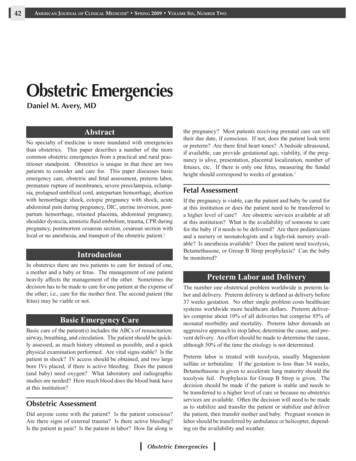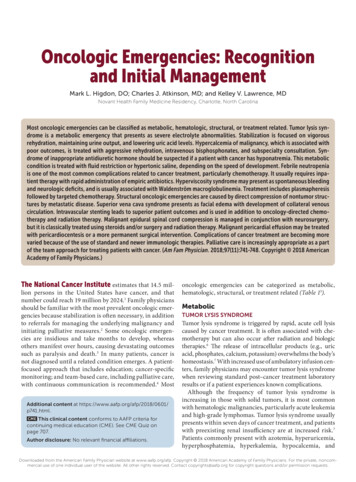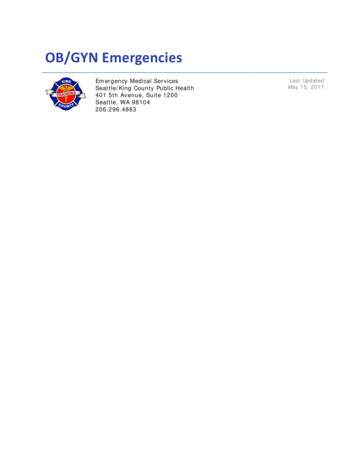
Transcription
42American Journal of Clinical Medicine Spring 2009 Volume Six, Number TwoObstetric EmergenciesDaniel M. Avery, MDAbstractNo specialty of medicine is more inundated with emergenciesthan obstetrics. This paper describes a number of the morecommon obstetric emergencies from a practical and rural practitioner standpoint. Obstetrics is unique in that there are twopatients to consider and care for. This paper discusses basicemergency care, obstetric and fetal assessment, preterm labor,premature rupture of membranes, severe preeclampsia, eclampsia, prolapsed umbilical cord, antepartum hemorrhage, abortionwith hemorrhagic shock, ectopic pregnancy with shock, acuteabdominal pain during pregnancy, DIC, uterine inversion, postpartum hemorrhage, retained placenta, abdominal pregnancy,shoulder dystocia, amniotic fluid embolism, trauma, CPR duringpregnancy, postmortem cesarean section, cesarean section withlocal or no anesthesia, and transport of the obstetric patient.1IntroductionIn obstetrics there are two patients to care for instead of one,a mother and a baby or fetus. The management of one patientheavily affects the management of the other. Sometimes thedecision has to be made to care for one patient at the expense ofthe other; i.e., care for the mother first. The second patient (thefetus) may be viable or not.Basic Emergency CareBasic care of the patient(s) includes the ABCs of resuscitation:airway, breathing, and circulation. The patient should be quickly assessed, as much history obtained as possible, and a quickphysical examination performed. Are vital signs stable? Is thepatient in shock? IV access should be obtained, and two largebore IVs placed, if there is active bleeding. Does the patient(and baby) need oxygen? What laboratory and radiographicstudies are needed? How much blood does the blood bank haveat this institution?Obstetric AssessmentDid anyone come with the patient? Is the patient conscious?Are there signs of external trauma? Is there active bleeding?Is the patient in pain? Is the patient in labor? How far along isthe pregnancy? Most patients receiving prenatal care can telltheir due date, if conscious. If not, does the patient look termor preterm? Are there fetal heart tones? A bedside ultrasound,if available, can provide gestational age, viability, if the pregnancy is alive, presentation, placental localization, number offetuses, etc. If there is only one fetus, measuring the fundalheight should correspond to weeks of gestation.1Fetal AssessmentIf the pregnancy is viable, can the patient and baby be cared forat this institution or does the patient need to be transferred toa higher level of care? Are obstetric services available at allat this institution? What is the availability of someone to carefor the baby if it needs to be delivered? Are there pediatriciansand a nursery or neonatologists and a high-risk nursery available? Is anesthesia available? Does the patient need tocolysis,Betamethasone, or Group B Strep prophylaxis? Can the babybe monitored?Preterm Labor and DeliveryThe number one obstetrical problem worldwide is preterm labor and delivery. Preterm delivery is defined as delivery before37 weeks gestation. No other single problem costs healthcaresystems worldwide more healthcare dollars. Preterm deliveries comprise about 10% of all deliveries but comprise 85% ofneonatal morbidity and mortality. Preterm labor demands anaggressive approach to stop labor, determine the cause, and prevent delivery. An effort should be made to determine the cause,although 50% of the time the etiology is not determined.Preterm labor is treated with tocolysis, usually Magnesiumsulfate or terbutaline. If the gestation is less than 34 weeks,Betamethasone is given to accelerate lung maturity should thetocolysis fail. Prophylaxis for Group B Strep is given. Thedecision should be made if the patient is stable and needs tobe transferred to a higher level of care or because no obstetricsservices are available. Often the decision will need to be madeas to stabilize and transfer the patient or stabilize and deliverthe patient, then transfer mother and baby. Pregnant women inlabor should be transferred by ambulance or helicopter, depending on the availability and weather.Obstetric Emergencies
American Journal of Clinical Medicine Spring 2009 Volume Six, Number TwoIf the patient is in labor, a labor and delivery nurse should accompany the patient in the ambulance. If delivery is imminent or likely en route, the obstetrician or a physician capableof performing a vaginal delivery should ride with the patient.For helicopter transports, there is usually not room for a physician or even a nurse to accompany the patient. Most helicoptertransports will be equipped with a physician and nurse capableof managing a vaginal delivery aboard.Sometimes delivery is imminent in an institution in which thereare no obstetric services at all. A physician capable of performing a vaginal delivery and a nurse should accompany the patientin transport. Today, most tertiary and quaternary institutions willnot accept the transfer of a pregnant laboring patient withoutboth physician accompanying the patient and the patient signinga waiver of liability to the accepting institution. Many acceptinginstitutions require that the patient be stable prior to transfer.Contraindications to tocolysis include cardiac disease, severefetal anomalies, hyperthyroidism, severe migraine headache,uncontrolled diabetes, advanced cervical dilatation and fetaldistress.1 Fetal distress should be managed prior to transfer,if at all possible. Prophylactic tocolysis is often used duringtransfer, if not contraindicated, to minimize the risk of deliveryen route.1Premature Rupture of MembranesPremature rupture of membranes is a second important obstetric emergency. Fluid coming from the vagina is ruptured membranes until proven otherwise. The diagnosis is made by sterilespeculum examination with nitrazine, pooling, ferning and/orultrasound estimation of amniotic fluid volume. Amniocentesiswith instillation of methylene blue may also be used to make thediagnosis. At sterile speculum examination, dilatation of the cervix should be noted. A closed cervix as opposed to a completelydilated cervix with impending delivery will affect management.Is delivery imminent? What is the presenting part? Is the fetusviable? What is the gestational age? Ultrasound can be used toanswer these questions. Much the same as preterm labor, canthis patient be cared for in this institution or does she need to betransferred? Will she need to be delivered and stabilized first,then transferred?Severe PreeclampsiaSevere preeclampsia is also an obstetric emergency demandingimmediate treatment. A systolic blood pressure of 160 mm Hgor diastolic of 110 mm Hg needs immediate intervention. Thediagnosis of severe PIH is also made by proteinuria of 5 gramson a 24-hour collection or 3 on a dipstick of a random specimen. Oliguria of 500 cc urine output over 24 hours, any CNSsymptoms, pulmonary edema or cyanosis, impaired liver function tests, low platelets, intrauterine growth restriction, or rightupper quadrant abdominal pain also confirm the diagnosis.1The cure for severe preeclampsia is delivery, regardless of gestational age. Magnesium sulfate is used to prevent seizures,hydralazine to control blood pressure after the loading dose ofmagnesium, and Lasix reserved for pulmonary edema. Diuretics are used only for pulmonary edema and congestive failure,due to their increased risk of precipitating a pulmonary embolus. A vaginal delivery is hoped for, and cesarean sectionis used for failed inductions, malpresentations, or worseningblood pressures.2Magnesium is continued for at least 24 hours postpartum andoften 48 hours. Preeclampsia can develop up to two weekspostpartum. Therapeutic levels of magnesium are in the 4-6range with levels obtained every six hours usually. If the creatinine is 1.3 or above, reduce the magnesium infusion rate by50%.2 The higher the infusion rate of magnesium, the morefrequently magnesium levels are checked.EclampsiaEclampsia is generalized seizures occurring usually with preeclampsia. They are antepartum 50% of the time and 91% occurafter 28 weeks. The differential diagnosis includes epilepsy,uncontrolled hypertension, lupus, intracranial hemorrhage,brain tumors, aneurysms, ITP, Metabolic Disorders, CerebralVasculitis, Cavernous Vein Thrombosis, Postdural Puncture,CVA, and inadvertent vascular injection of anesthetic used forepidural anesthesia.2 The latter is usually accompanied by ametallic taste, an aura, and “strange feeling” before seizing.Cerebral imaging is not always necessary unless there are focal changes, the seizures recurrent, deterioration of the patient’scondition, or the need to exclude other etiologies.2 Usually thecure is delivery, and it should not be withheld for Betamethasone. Avoid diuretics unless there is pulmonary edema. Restrictfluids to reduce the incidence of cerebral edema. The treatmentis magnesium sulfate. If the patient is on magnesium and seizing, then more magnesium is needed. Rarely, is a second lineanticonvulsant needed. Hydralazine and labetolol are used totreat blood pressure. Nitroglycerine may be necessary postpartum. Systolic blood pressures 160 mm Hg and diastolic 110mm Hg increase the likelihood of stroke.Prolapsed Umbilical CordA prolapsed umbilical cord is an obstetric emergency in whichcompression of the umbilical cord can have fatal results if notrelieved quickly. If the membranes are not ruptured, a cord presentation, as it is called, is a disaster waiting to happen. Compression of the cord by the presenting part compresses umbilical vessels, causing hypoxia. The diagnosis is made by fetalheart rate tracing and vaginal examination. While a prolapsedcord can occur spontaneously, most often it occurs after artificial rupture of membranes from a high station before the headis engaged. Basically, the loose umbilical cord is washed outof the vagina with the flow of amniotic fluid and the effect ofgravity. While most obstetricians have at one time or anotherObstetric Emergencies43
44American Journal of Clinical Medicine Spring 2009 Volume Six, Number Twotried replacing the cord into the uterus, it is not successful. It isimportant to know if the baby is alive, gestation age if viable,and if there are anomalies.1The cord compression is relieved by elevating the fetal headvaginally while preparing for cesarean section. Elevation maybe assisted by placing the mother in deep Trendelenburg position or knee-chest. An operative vaginal delivery may beconsidered if the cervix is completely dilated and the head islow in the pelvis.Antepartum HemorrhageAntepartum hemorrhage is the newer term applied to what usedto be called third trimester bleeding. By definition, antepartumhemorrhage is bleeding during the second half of pregnancy.Other definitions include bleeding after viability, often after 24weeks. The most common cause of mild bleeding is sexualintercourse and is usually self-limited. Significant causes ofbleeding include placenta previa, placental abruption, vasa previa, and uterine rupture.Vasa previa is presentation of umbilical vessels lacking Wharton’s Jelly below the presenting part. Rupture of a vessel causesbleeding from the baby. Placental abruption is premature separation of the placenta due to bleeding, characterized by significant pain, uterine tetany and shock, with or without externalbleeding. Placenta previa is characterized by painless bleedingfrom the placenta covering the cervix. Cesarean section is usually the required method of delivery. Bleeding may occur inconjunction with uterine rupture from a previous cesarean section or uterine surgery, such as a myomectomy. Uterine ruptureis characterized by a fetal heart rate abnormality.require dilatation and curettage and occasionally evacuation ofthe uterus with dilatation and evacuation. The uterus is soft during pregnancy and very easy to perforate. Uterine perforationshould be a consideration in a patient with significant bleedingwho has already had a dilatation and curettage. For a patientwith a septic abortion, triple antibiotics should be given.Ectopic Pregnancy with ShockAn ectopic pregnancy with shock demands expedient surgicalmanagement, not medical or conservative. A patient with apositive pregnancy test and abdominal or pelvic pain is an ectopic pregnancy until proven otherwise. Abdominal ultrasoundshould visualize the site of a pregnancy in a normal size patientat a level of 5,000 to 6,000 mIU. A transvaginal ultrasoundshould be able to identify a pregnancy at a level of 1200-1500mIU. A patient with an ectopic pregnancy in shock needs acomplete blood count, quantitative Beta HCG, coagulationstudies, and a type and cross-match for blood. Two large boreIV lines should be placed. If the patient is Rh negative, she willrequire Rhogam.Acute Abdominal Pain During PregnancyThe degree of vaginal bleeding or the fetal heart rate abnormality will dictate the delivery, regardless of gestational age. Ultrasound is helpful making the diagnosis. If ultrasound is unavailable, a double set-up in the operating room may be helpful.Anything causing pain in a woman not pregnant can also causepain during pregnancy. The number one cause of abdominalpain during pregnancy is uterine contractions due to labor.Other causes include acute appendicitis, ruptured liver, ruptured spleen, acute cholecystitis, pyelonephritis, ovarian torsion, trauma, placental abruption, uterine rupture, small bowelobstruction, infarcted fibroid, round ligament pain, renal stone,ureteral obstruction due to an enlarging uterus, ruptured aneurysm, and pelvic abscess. Management depends on the diagnosis. Practitioners should bear in mind that any abdominal orpelvic surgery will almost always cause uterine contractions.For this reason, exploratory laparotomy after 35 weeks gestation should include a cesarean delivery.Abortion
sia, prolapsed umbilical cord, antepartum hemorrhage, abortion with hemorrhagic shock, ectopic pregnancy with shock, acute abdominal pain during pregnancy, DIC, uterine inversion, post- partum hemorrhage, retained placenta, abdominal pregnancy, shoulder dystocia, amniotic fluid embolism, trauma, CPR during pregnancy, postmortem cesarean section, cesarean section with local or no











